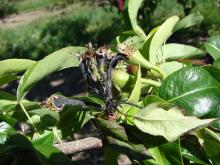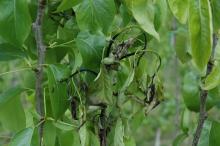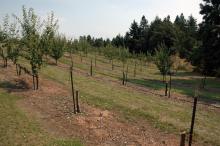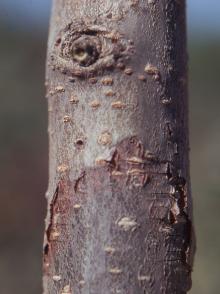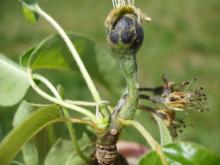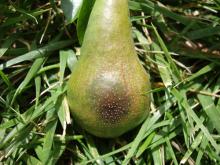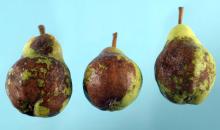See:
Apple (Malus spp.) - Fire Blight
Pear, Asian Cultivar Susceptibility
Cause Erwinia amylovora, a bacterium that overwinters in cankers on infected pear, apple, and some ornamental trees. Risk of infection increases with the number of more active "holdover" cankers in an orchard. Insects, pruning tools, and splashing rains spread this bacterium. Bacteria enter healthy, main bloom or rattail blossoms through the stigma, nectary, anthers, and sepals. A temperature of 65°F or higher in a 24-hour period plus a trace of rain or high humidity (greater than 65%) is necessary for infection. Flowers, which are open for up to 3 days, support rapid growth of the bacteria while older flowers do not. Vigorously growing shoot tips, young leaves, and wounds also can be infection sites. Entrance into healthy appearing leaves and shoots may be through the base of epidermal hairs. Symptomless pears are not a source of the pathogen, which is rarely detected (1 out of 5,600 fruit) as an epiphyte on commercially-produced fruit.
Primary insect vectors include ants, flies, and wasps. Aphids, flies, ants, leafhoppers and tarnished plant bugs have been implicated in the spread of fire blight. Flies and ants are attracted to the bacterial ooze and can then carry it to uninfected blossoms. Bees do not feed on bacterial ooze but can visit infected flowers and spread bacteria to uninfected flowers. Although bees have been shown to be capable of transmission in controlled conditions, field-collected pollinating bees in New York did not test positive for the bacterium.
All important pear cultivars are susceptible to fire blight, including Bosc. Fire blight also severely attacks apple, cotoneaster, photinia, pyracantha, hawthorn, quince, and mountain ash. Fire blight may be very serious some years but appears hardly at all in others. It is sporadic in Milton Freewater, Hood River, and Medford, OR and in Yakima and Wenatchee, WA. Since the mid-1990s, the disease has become very important to apple growers because susceptible cultivars have been planted widely. It is not common in Oregon's Willamette Valley and may be confused there with Pseudomonas blight. In a "fire blight year," young trees, especially those trained to a central leader, can be severely damaged.
Symptoms During moist periods in the bloom season, spurs, blossoms, and twigs may become infected, developing a darker, water-soaked appearance. They turn brown to black and rapidly wilt and die. Infected blossoms frequently are distorted. A tan-yellow bacterial exudate (ooze) often appears where infection occurs.
Cankers develop on trunks, limbs, and the graft union. Cankers are at first water soaked, later brownish red, and ultimately dark brown or black. Bark covering the cankered area is sunken, rougher and separates from injured tissue. Severe cankers girdle and kill infected limbs. The cultivar Concord may show trunk cankers first before symptoms on flowers or shoots.
Other problems that can be confused with fire blight include Pseudomonas blossom blast, Nectria twig blight, pear dieback caused by Phomopsis sp., and twig borer beetle damage.
Cultural control This disease can cause serious losses and all personnel from growers to extension agents should have a full understanding of management tactics and apply them rigorously. Use an integration of many tactics, from sanitation to timely application of chemical to biological products, to manage this disease.
- Remove and immediately burn all traces of blight as noticed. Thorough blight cutting requires training and good equipment (such as special blight-cutting or scraping knives), a supply of sterilizing solution, and several trips through the orchard. Do not combine pruning and blight cutting. Use lots of sterilizing solution on all tools and large cuts. Soak tools in solution after every cut. Use 10% Clorox (which is corrosive), 70% ethanol, 70% isopropanol (rubbing alcohol), or Pine-Sol. If used as a soak, change solutions every 2 to 3 hours. Do not cut when trees are wet from rain, irrigation, or dew. Do not break off infected shoots by hand.
- If early bloom is severely infected, delay cutting until you determine the infection's extent. Cut out late bloom infections as soon as noticed. In spring and summer, cut at least 12 to 18 inches past any visible discoloration.
- Scout orchards for symptoms 7 to 10 days after hail or severe storms.
- In fall, immediately after harvest, or during the dormant season inspect the orchard and remove all infections missed earlier. Cutting 4 to 6 inches beyond discoloration is enough at this time.
- Cauterizing cankers using a hand-held propane burner has been used with some success.
- When cutting on fully dormant trees sterilizing tools is not necessary.
- Prevent excessive shoot and sucker growth by using moderate amounts of nitrogen fertilizer. Nitrogen applications can be split using half the recommended amount before growth starts in the spring. If fire blight is not a major issue the rest of the nitrogen can be applied after bloom.
- Remove late blooms during fruit thinning. If feasible, remove blooms before they open the first year after planting. Also remove blossoms on young nonbearing trees.
- In young orchards with susceptible cultivars and/or rootstocks, remove and destroy severely infected young trees. Replanting is more effective and less risky in the long run. Also, check new nursery trees for any symptoms of fire blight.
- Scion wood should not be collected from trees with fire blight or within 60 feet of trees with fire blight.
- Remove nearby landscape, such as hawthorns, or fence-row trees that can be a source of inoculum.
- Avoid overhead irrigation. Reducing irrigation in a vigorous orchard with fire blight strikes may slow development of blight observed on new shoots. In arid areas, reducing irrigation in the spring helps reduce the potential for dew formation on flowers.
- Some minor cultivars are resistant including Blake's Pride.
Forecasting Many systems have been developed to help growers determine when weather conditions have been, are, or will be conducive to fire blight development. Some are fairly simple, others are more complex. Each one involves measuring air temperature and humidity or rainfall. A temperature-based system, called Cougarblight, was developed in Washington and is the best one for use in the PNW. Sprays are initiated from 150 to more than 500 degree-hours depending on the proximity of known sources of fire blight.
Several systems have been developed in California. The mean-temperature-line system, developed in the 1970s, initiates the first regular spray when the average daily temperature exceeds a line drawn from 62°F on March 1 to 58°F on May 1. The degree-hour system, also developed in the 1970s, initiates sprays before the next rain when 150 degree-hours have accumulated.
The Illinois system, developed in the 1960s, calculates degree-days; that is, the number of degrees above 65°F between the latest prebloom freeze and the early bloom period. (For example, if the maximum temperature for one day is 75°F, that equals 10 degree-days.) A total of 30 degree-days and the prediction of warm (70°F to 80°F), wet weather initiates the first spray. Observations in Medford, OR indicated a trigger of 25 degree-days was more accurate under Rogue Valley conditions.
Maryblyt, developed in the 1980s, is a detailed program that identifies conditions conducive to four different fire blight symptoms, identifies infection events, and predicts symptom development. Studies in Wenatchee, WA found it overpredicted fire blight; similar studies in Hood River, OR found it underpredicted fire blight.
Chemical control Integration of chemical and biological tactics has worked well in the PNW. Keeping bacterial populations low during bloom, with various products and timing antibiotic applications to coincide with infection periods, has been a successful strategy in the PNW. Use a delayed dormant application of a copper-based product if fire blight was active in your orchard last year. Use biological materials as trees go into bloom and again at full bloom supplemented with an antibiotic. Use antibiotics when infection periods are detected with the Cougarblight program. Continue with an antibiotic program during rat tail bloom (also called second bloom or scattered bloom).
Organic production of pome fruit should use Blossom Protect at 70% bloom, a soluble copper (such as Previsto) at full bloom, and a Bacillus-based biorational at petal fall, for the best balance in quality of infection suppression with the risk of fruit russeting.
- Delayed dormant sprays of copper compounds plus oil can delay and/or reduce inoculum production in holdover cankers missed after pruning. The use of copper-based products at this time is not always effective and was found in Israel to not reduce disease intensity during bloom. Work in the 2010's in California showed less infection during bloom. Group M1 fungicides. O
- Bonide Copper Fungicide at 2 to 4.3 oz/3 to 9 gal water. Group M1 fungicide. H
- Bordeaux 8-8-100.
- Champ WG at 12 to 16 lb/A. 48-hr reentry.
- C-O-C-S WDG at 12 to 15.6 lb/100 gal water. 48-hr reentry.
- Cuprofix Ultra 40 Disperss at 7.5 to 10 lb/A. 48-hr reentry.
- Instill at 20 to 40 fl oz/100 gal water. 48-hr reentry.
- Kocide 50 DF at 8 to 12 lb/A. 48-hr reentry.
- ManKocide at 1.5 lb/A. 48-hr reentry.
- Nu-Cop 50 DF at 4 to 12 lb/A. 48-hr reentry.
- Previsto at 2 to 4 quarts/A. Do not tank mix with any other product. 48-hr reentry. O
- Although regular bactericide sprays during main bloom season have been effective, they only encourage development of resistant bacteria. Tank-mix or alternate bactericides to prevent or delay development of resistant bacteria. Time initial and subsequent sprays according to one of several forecasting systems, or local recommendations, or as soon as possible after severe spring storms. Applications greater than 24 hours before or after infection give poor control. Good spray coverage is important in getting good results. Antibiotics such as oxytetracycline and kasugamycin are sensitive to rapid degradation in strong sunlight. Antibiotics also work better when the spray solution acidity is low. (Note that a citric acid product, FungOut, is labeled for apple). Although copper at full bloom is key for organic programs, copper hydroxide products are toxic to honey bees.
- Badge X2 at 0.5 to 1 lb/A. Do not use on sensitive pears to avoid russeting. Group M1 fungicide. 48-hr reentry. O
- Champ WG at 1 to 3 lb/A. Do not use on 'Anjou', 'Comice', or 'Forelle' pears to avoid severe russeting. Group M1 fungicide. 48-hr reentry.
- C-O-C-S WDG at 0.5 to 1 lb/A. Do not use on 'Anjou', 'Comice', or 'Forelle' pears to avoid severe russeting. Group M1 fungicide. 48-hr reentry.
- CS 2005 at 19.2 oz/A. Group M1 fungicide. 48-hr reentry.
- Cueva at 0.5 to 1 gal/100 gal water/A. Rated as good as some of the antibiotics. Group M1 fungicide. 4-hr reentry. O
- Dart at 25.6 to 44.8 fl oz/100 gal water. Spray with continuous agitation. Was phytotoxic to Braeburn apple in one Western Oregon test. 24-hr reentry. O
- Grotto at 102 gal/A. Group M1 fungicide. 4-hr reentry.
- Kasumin 2L at 64 fl oz/A plus oxytetracycline Do not use alternate-row applications, or after petal fall, or within 90 days of harvest. Do not use in orchards fertilized with animal manure. Not for nursery production. Acidification of the spray tank with citric acid-based products may help improve efficacy. Group 24 fungicide. 12-hr reentry.
- Kocide 3000 at 0.5 lb/A. Do not use on 'Anjou', 'Comice', or 'Forelle' pears to avoid severe russeting. Group M1 fungicide. 48-hr reentry.
- Nu-Cop 50 DF at 1 to 3 lb/A. Do not use on 'Anjou', 'Comice', or 'Forelle' pears to avoid severe russeting. Group M1 fungicide. 48-hr reentry. O
- Oxytetracycline, is contained in several products including Fire Line and Mycoshield. For example, use Fire Line at 8 or 16 oz/A. Use 8 oz/50 gal/A water or 16 oz/100 gal/A water. Acidification of the spray tank with citric acid-based products may help improve efficacy. Do not apply within 60 days of harvest. Low resistance risk and provides fair to very good control. However, excessive use in one California pear orchard resulted in resistant fire blight bacteria. May cause injury to Asian pears. Group 41 fungicide. 12-hr reentry. O
- Previsto at 2 to 4 quarts/A. Do not tank mix with any other product. Do not use on 'Anjou', 'Comice', or 'Forelle' pears to avoid severe russeting. Group M1 fungicide. 48-hr reentry. O
- Streptomycin sulfate is contained in several products including Agri-Mycin, FireWall, and Harbour. For example, use Agri-Mycin 50 at 8 to 16 oz/A. Use once and mixed with oxytetracycline. Do not apply within 30 days of pear harvest or 50 days of apple harvest. Resistant strains of the fire blight bacterium have been detected in most pear-growing regions of the Pacific Northwest. About a 2-year shelf life. Excellent control if resistance is not a problem. Group 25 fungicide. 12-hr reentry. O
- Sprays of the above bactericides also are needed any time there are late blooms and weather conducive to disease development, especially for pear. However, these later applications are ineffective against shoot tip or wound infections.
- Mycoject Ultra is labeled as a tree injection for non-bearing trees only. Do not inject trees less than 2 inches in diameter. Group 41 fungicide. 12-hr rentry.
- Surface disinfectants such as Oxidate 5.0 or Jet-Ag are registered but have very short residual activity. Although use at late bloom helps to kill residual bacteria, under some conditions this application can mark fruit. Manufacturers recommend not to use past full bloom and should be applied only in fast drying conditions.
- Actigard 50 WG at 1 to 2 oz/A plus an antibiotic. Can also be used at 1 oz/quart of 1% penetrant (silicone surfactant), as a paint, to pruned limbs left after cutting out blight. Paint 1 to 1.5 ft starting from pruning cut. Do not apply within 60 days of harvest. Useful for infected trees 3-to-10-years old (replace younger infected trees). Group P01 fungicide. 12-hr reentry.
Notes: Group P7 fungicides such as Aliette WDG and Rampart (or Monterey Garden Phos for the home) are registered for apple and pear and Aliette is registered for ornamental pears, but these products are not recommended as foliar applications because control is too variable and the materials are not compatible with copper products. Trunk injection of a similar product was better than nothing in Michigan but has not been evaluated in the PNW.
Vacciplant is registered but was ineffective in the PNW and thus is not recommend for use.
Some registered products offer only suppression of this disease and thus are not recommended for use. These products include DoubleNickel 55, Regalia, and Stargus.
Biological control Use in conjunction with other control tactics such as thorough sanitation and antibiotics. Use only after the use of lime sulfur products. For organic production, however, use Blossom Protect at 70% bloom, a soluble copper at full bloom, and a Bacillus-based product at petal fall.
- AgriPhage-Fireblight at 1 to 2 quarts/50 to 100 gal water. Keep pH between 6.0 and 8.5. Do not mix with or apply within 4 days of iron or copper products. Variable results reported from eastern North America. 4-hr reentry. O
- Blossom Protect (Aureobasidium pullulans) at 2.5 lb/2 A plus 17.5 lb Buffer Protect. Use at 15% to 20% bloom and again at full bloom to petal fall. First application should be applied to all trees (rather than alternate row spraying.) If crop load thinning in early bloom with lime sulfur or ATS, delay first use of Blossom Protect until full bloom. Blossom Protect yeast need about 12 hours to grow on the flower to protect blooms before a wetting event. May enhance russeting on some cultivars when applied late bloom. Use in conjunction with other control tactics such as thorough sanitation and antibiotics. Not compatible with many pesticides or additives, a compatibility list is available. Do not use following an application of a copper-based product or severe russeting will occur. Excellent control. 4-hr reentry. O
- BotryStop (Urocladium oudemansii U3 strain) at 2 to 4 lb/A. Keep refrigerated before use. Compatible with many wetting agents, some fungicides and biologicals, but not all. Unknown efficacy in the PNW. 4-hr reentry. O
- LifeGard WG (Bacillus mycoides isolate J) at 4.5 oz/100 gal water. Does not have direct activity on pathogens but stimulates host defenses. Variable efficacy in Eastern States. Group P06 fungicide. 4-hr reentry. O
- Serenade Opti (Bacillus subtilis strain QST 713) at 14 to 20 oz/A. Active ingredient is basically an antibiotic so use late in bloom like you would oxytetracycline. It does not work if used like the biologicals early in the bloom season. Fair to good control. 4-hr reentry. O
- Stargus (Bacillus amyloliquefaciens strain F727) at 1 to 4 quarts/A plus a nonionic surfactant. Do not use after petal fall. Fair control. 4-hr reentry. O
References Elkins, R.B., Temple, T.N., Shaffer, C.A., Ingels, C.A., Lindow, S.B., Zoller, B.G., and Johnson, K. 2015. Evaluation of dormant-stage inoculum sanitation as a component of a fire blight management program for fresh market Bartlett pear. Plant Disease 99:1147-1152.
Johnson, K. B., Temple, T. N. and Kc, A. N. 2023. Acidifying spray suspensions of oxytetracycline and kasugamycin enhances their effectiveness for fire blight control in apple and pear. Phytopathology, 113:2205-2214.
Johnson, K.B., Temple, T.N., Kc, A. and Elkins, R.B., 2022. Refinement of Nonantibiotic Spray Programs for Fire Blight Control in Organic Pome Fruit. Plant Disease. 106:623-633.
Van Der Zwet, T., Orolaza-Halbrendt, N., and Zeller, W. 2012. Fire Blight: History, Biology, and Management. APS Press/American Phytopathological Society.
Yuan, X., Gdanetz, K., Outwater, C. A., Slack, S. M. and Sundin, G. W. 2023. Evaluation of plant defense inducers and plant growth regulators for fire blight management using transcriptome studies and field assessments. Phytopathology, 113:2152-2164.


